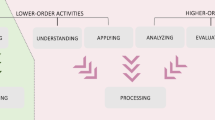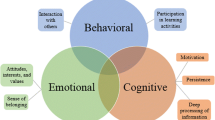Abstract
Colleges and universities have made considerable effort to get students to use information technology productively. This study uses data from the 2003 administration of the National Survey of Student Engagement (NSSE) to investigate the relationships between student uses of information technology and other forms of student engagement. There appears to be a strong positive relationship between using information technology for educational purposes and involvement in effective educational practices such as active and collaborative learning and student–faculty interaction. The results also point to the prospect that particular areas of involvement with information technology could be viewed as forms of engagement in and of themselves. In addition, when students use information technology it may increase their opportunities for other types of engagement.
Similar content being viewed by others
References
M. Alavi (1994). Computer-mediated collaborative learning: An empirical evaluation. MIS Quarterly June: 159–174
R. M. Carini J. H. Hayek G. D. Kuh J. M. Kennedy J. A. Ouimet (2003) ArticleTitleCollege student responses to web and paper surveys: Does mode matter? Research in Higher Education 44 1–19
A. W. Chickering Z. F. Gamson (1987) ArticleTitleSeven principles for food practice in undergraduate education AAHE Bulletin 39 IssueID7 3–7
A. Dillon R. Gabbard (1998) ArticleTitleHypermedia as an educational technology: A review of the quantitative research literature on learner comprehension, control and style Review of Educational Research 68 322–349
M. G. Dolence D. M. Norris (1995) Transforming higher education: A vision for learning in the 21st century Society for College and University Planning Ann Arbor, MI
L. Flowers E. T. Pascarella C. T. Pierson (2000) ArticleTitleInformation technology use and cognitive outcomes in the first year of college Journal of Higher Education 71 IssueID6 637–667
L. E. Gladieux W. S. Swail (1999) The virtual university and educational opportunity: Issues of equity and access for the next generation College Board Washington, DC
K. C. Green (1996) ArticleTitleThe coming ubiquity of information technology Change 28 IssueID2 24–28
HuS., and KuhG. D. (2001). Computing experience and good practices in undergraduate education: Does the degree of campus ΓÇ£wirednessΓÇ¥ matter? Education Policy Analysis Archives, 9(49). Retrieved January 26, 2004 from http://epaa. asu.edu/epaa/v9n49.html..
Institute for Higher Education Policy (1999). Distance learning in higher education, Washington, DC: Author.
Kennedy, C. (2000). Implications for new pedagogy in higher education: Can online technology enhance student engagement and learning? (ERIC Document Reproduction Service No. ED443382).
G. D. Kuh (2001a) ArticleTitleAssessing what really matters to student learning: Inside the National Survey of Student Engagement Change 33 IssueID3 10–17, 66
G. D. Kuh (2001b) The National Survey of Student Engagement: Conceptual framework and overview of psychometric properties Indiana University Center for Postsecondary Research Bloomington
G. D. Kuh (2003) ArticleTitleWhat we’re learning about student engagement from NSSE Change 35 IssueID2 24–32
G. D. Kuh S. Hu (2001) ArticleTitleThe relationships between computer and information technology usestudent learning, and other college experiences Journal of College Student Development 42 217–232
G. D. Kuh N. Vesper (2001) ArticleTitleDo computers enhance or detract from student learning? Research in Higher Education 42 87–102
National Survey of Student Engagement (2003). Converting Data into Action: Expanding the Boundaries of Institutional Improvement. Bloomington, IN: Indiana University Center for Postsecondary Research.
D. Oblinger M. Maruyama (1996) Distributed learning CAUSE BoulderCO
Reisberg, L. (2000, June 5). 10% of students may spend too much time onlinestudy suggests. The Chronicle of Higher Education [On-line]. Retrieved May 25, 2004 from http://chronicle.com/free/2000/06/2000060501t.htm.
Student Monitor (2003). Computing and the Internet: Fall 2002. RidgewoodNJ: Author.
C. A. Twigg (2004) Improving Learning and Reducing Costs: Lessons Learned from Round II of the Pew Grant Program in Course Redesign Center for Academic Transformation Troy, NY
R. G. Wingard (2004) ArticleTitleClassroom teaching changes in web-enhanced courses: A multi-institutional study EDUCAUSE Quarterly 27 IssueID1 26–35
Author information
Authors and Affiliations
Corresponding author
Rights and permissions
About this article
Cite this article
Laird, T.F.N., Kuh, G.D. Student Experiences With Information Technology And Their Relationship To Other Aspects Of Student Engagement. Res High Educ 46, 211–233 (2005). https://doi.org/10.1007/s11162-004-1600-y
Received:
Issue Date:
DOI: https://doi.org/10.1007/s11162-004-1600-y




